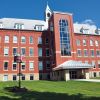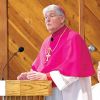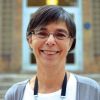St. Peter’s continues to plan for future
MUENSTER, SASK. - The staff of St. Peter’s College has only one major hurdle to overcome to bring the renovations of Michael Hall, the college building, to an end — namely, completing the fundraising to pay for the final renovation costs, which are close to $4 million.
The success of a recent open house at the college showed that goal can be reached, as there was much enthusiasm and support for the college. The public still considers St. Peter’s College to be an important part of the local district and larger community, according to Robert Harasymchuk, college president.
“Fundraising is a necessary element of St. Peter’s success. The Michael Hall renovations have necessitated financing that we hope will be supported through the generosity of our alumni and the community that supports and depends on St. Peter’s as a hub for sport, culture, recreation and of course learning,” he said. “We are continually seeking ways to improve and expand our programs and services and this is possible with the help of our college supporters.”
St. Peter’s was founded in 1921 by the Benedictine monks of St. Peter’s Abbey and since 1926 has been affiliated with the University of Saskatchewan.
Abbot Peter Novecosky, OSB, chancellor of the college, cut the ribbon to officially re-open Michael Hall after four years of renovations which cost $15 million. The renovations began as a dream 10 years ago, he remarked.
“A number of the alumni commented on the amazing transformation that Michael Hall has undergone,” Harasymchuk said in an interview.
“Although the building looked new in appearance, they said it still had the same ‘feel,’ a testament to the talent of architect Maurice Soloudre in blending the need for modern conveniences while maintaining the tradition and heritage of the building. We also heard some remarks that although many people knew it was a huge undertaking for the college, the renovations were worth it to know that students would benefit from the college for decades to come.”
Renovations affected every floor of Michael Hall, which was gutted, rebuilt and refurbished with new floors, walls, doors, lighting and windows. Doorway entrances were widened, bathrooms upgraded and wiring brought up to standard to enable information technology systems to be used. There are three new science labs on the basement floor. Students can study and visit in a lounge and recreation room, and exercise in a modern fitness centre. One of the most noticeable changes is the new elevator and shaft, an addition to the west side of the building.
Renovations were made possible through the federal Knowledge Infrastructure grant program, the provincial Ministry of Advanced Education, donations from alumni and others who gave to the capital campaign. Miners Construction was the project manager. Support was provided by the college board of governors and the monks of St. Peter’s Abbey.
(Prairie Messenger)
This is no ordinary musical period
TORONTO - It’s hard to believe, watching John Edwards cradle his giant lute-like theorbo, that the music he is playing could be considered anything but sacred.
As he moves his fingers over the instrument’s neck, the delicate strains of Monteverdi that blossom are both rapturous and heavenly.
However, as Edwards notes, these divine melodies were often the product of secular compositions that hoped to draw in churchgoers during the Catholic Church’s Counter-Reformation.
“While the Protestants are doing three-hour sermons, the mention of the Baroque is sort of for the Counter-Reformation to put ‘sparkly things’ to draw you in that way,” laughs Edwards, one part of The Musicians in Ordinary, who have been commissioned by the University of St. Michael’s College to conduct the Principal’s Music Series for the 2012-13 season. The series launched Oct. 23.
St. Michael’s is acting as a patron of the event, which will serve not only as a one-of-a-kind concert opportunity for students, but also function as an educational exploration of a remarkable period in musical history.
The Musicians in Ordinary are a two-person ensemble of John Edwards, on the towering, lute-like theorbo, and soprano Hallie Fishel. Joined by some of Toronto’s pre-eminent Baroque musicians, Edwards and Fishel will be presenting four concerts that explore the music of the Renaissance and Baroque periods that often times blurred the lines between sacred and secular.
As an example, Edwards displays an image of The Ecstasy of St. Theresa, a famous marble sculpture by Bernini, that is at once a display of reverence and sensuality. The idea, explains Edwards, was for the Church to capitalize on the popularity of the Baroque esthetic that would appeal to the general population as they attended church as well.
“That was what they were aiming for: to draw the people in. So, it seemed... that they were seeing it as giving the public at large an access to the arts, in a way,” said Edwards.
“I think that one of the things, with the Counter-Reformation, they try and use Mary as a ‘selling point’ to draw you in.”
Monteverdi, one of the most popular composers of the time, is featured in the series’ opening concert, along with works by Barbara Strozzi, a courtesan, and Isabella Leonardi, an Ursuline nun, among others. It seems a great study in contrast to hear the works of a courtesan, who writes in her “O Maria”: “She has conformed the hearts of all to her virtue, and she delights in the heritage of the Lord.”
“Luckily they’re inventing opera at the same time, and Monteverdi was an opera composer,” said Edwards. “So he’s using the same tricks as he would use to make you fall in love with Orfeo that he uses those to make you fall in love with the Virgin Mary.”
Monteverdi (who in addition to being a popular opera composer was also the maestro di cappella at St. Mark’s in Venice) was a composer whose work was a foremost example of the transition between the polyphony of the Renaissance to the sheer emotionalism and complexity of Baroque music. This fit perfectly into the Counter-Reformation’s integration of secular elements to reinforce the faith.
“In some ways it’s similar to today; there’s a lot of changes in society... all of a sudden they have access to information. There are all these changes in the music, so how do you integrate things like this? We have some of the same problems in church music today,” said Edwards.
Take Monteverdi’s “Nigra sum,” for example, with text like: “I am black but comely, daughters of Jerusalem. Therefore the king has delighted in me and brought me to his chamber and said to me, ‘Arise, my love, and come.’ ”
This particular piece is from his Mass for six voices to the Most Holy Virgin, which Monteverdi notes is “suitable for the chapels or chambers of princes.” It seems unlikely we would hear such textual interpretation today.
“I think the music in this concert is composed so successfully that I think it can show us something too,” said Edwards of its lasting effect.
Along with Fishel and Edwards, audiences of the series will be able to see performances by Tafelmusik’s Christopher Verrette and Patricia Ahern (Baroque violin), and the noted organist Philip Fournier (organist and music director at St. Vincent de Paul Church). Additionally, several of the concerts in the series will feature pre-performance talks by some of the leading scholars in the field.
“That scholarship that we’ve been doing with these different people... it’s silly to do scholarship on the cultural context of performance, and then not do the music,” said Edwards.
“Luckily, with our residency at St. Mike’s, that’s given us a place to present some of this stuff to a real audience.”
For more see www.musiciansinordinary.ca or www.stmikes. utoronto.ca.
St. Jerome’s teams up with local school boards
Catholic higher education doesn’t start in a university lecture hall and doesn’t end with a black gown and a piece of paper under a new agreement St. Jerome’s University has signed with the Hamilton diocese and six Catholic school boards.
The agreement will allow the university, diocese and school boards to pool resources for adult education, volunteering, curriculum development and more.
“We look at it very positively as an excellent opportunity to support each other in the mission of Catholic education and to promote Catholic education as a life-long process,” Gus Hubbard, Hamilton Catholic District School Board superintendent of education, told The Catholic Register.
Hamilton, Brant-Haldimand Norfolk, Waterloo, Bruce-Grey, Halton and Wellington Catholic school boards are signatories to the agreement with St. Jerome’s.
Beginning with a casual conversation about Catholic education in Waterloo Region, the agreement was developed with Hamilton Bishop Doug Crosby’s encouragement over a year of meetings. The agreement was signed by all parties Sept. 20.
“It helps all partners to think about Catholic education as something that extends from a child’s early years through high school, post-secondary education and beyond,” said St. Jerome’s religious studies professor Cristina Vanin in an e-mail.
The joy of connecting with knowledge
For Barbara Decker Pierce, seeing the joy in the faces of those taking part in King’s College University’s Liberal Arts 101 course is priceless.
The co-founder of the free course offered to London’s underprivileged at the Catholic college at London, Ont.’s Western University, Pierce says she loves “the enthusiasm with which the participants come to the program.”
She enjoys “the look on their faces when they connect with knowledge, when they are treated with respect, when they feel like they’re part of something that is helping them grow as individuals.”
Pierce is the director of King’s School of Social Work. Though the program is run by King’s, it’s a joint activity between Western’s Registrar’s Office, the Dean of Students and the School of Social Work.
King’s is wrapping up the fifth session of its increasingly popular Liberal Arts 101 course. Every fall semester since 2008, the Catholic college has offered free university-level classes to underprivileged members of the London community.
Fifteen participants are selected for each session, and every Tuesday night for the duration of the program, a different liberal arts topic is covered.
This past semester, lectures covered serious issues facing First Nations communities, what psychoactive drugs really do to the mind and body, the economic rise of China, the history of electricity in Canada, the Occupy movement and understanding the U.S. sub-prime mortgage crisis.
The cross-section of subjects covered is largely dependent on which faculty members volunteer and what they would like to teach. This semester, there are six faculty volunteers.
“The faculty love it,” said Pierce. They enjoy “the love of learning that they see on the faces of people in the program.”
Pierce describes the participants as attentive and always eager to jot down notes and ask questions.
Before the lecture, each class begins with a communal meal.
“The meal is important I think in terms of showing hospitality,” said Pierce. It brings together classmates, faculty, the co-ordinators and the six or seven student volunteers from the School of Social Work.
After the meal, the lecture lasts for about an hour, followed by discussion groups.
“We divide into small groups for some questions that the lecture has presented or provided, and those small groups are facilitated by our social work students,” said Pierce.
“This is a chance for them to work on some of their facilitation skills and also to connect them to the participants.”
The program also provides bus tickets and child care subsidies to participants in need “to remove any barriers people might have from participating,” Pierce said.
Some participants attend the program to test their readiness for post-secondary education. Participants have included those with physical or psychiatric challenges, single parents, immigrants and refugees.
King’s College was founded in 1954 and is sponsored by the diocese of London. Its mission is in part “to foster an environment based on open inquiry, Christian values and service to the larger community.”
The Liberal Arts 101 program is run out of the School of Social Work, said Pierce, as “It’s consistent with our mission to reach out to community, to be present in our community, and it’s also consistent with the values of the School of Social Work, which are clearly to support and assist people in making change.”
The seventh and last class of the program is a dinner and awards night where participants are acknowledged for completing this non-credit course and asked what could be improved upon.
Brescia aims to develop the next women leaders
Felicity Sattan walked away from Brescia University’s Take the Lead contest a more confident young woman.
Sattan, now a third-year Nutrition and Family student at Canada’s only women’s university, was introduced to Brescia in 2010 when she competed in the London, Ont., school’s all-female public speaking contest. She was a finalist in that year’s contest.
“I always tell my profs and my classmates that Take the Lead was really instrumental in improving my public speaking skills and becoming more confident and just being an all round better presenter, which I think is an important skill in post-secondary,” Sattan said.
She uses those skills often and at least once a semester in each of her university classes.
Take the Lead has been held five times since 2008. It is a recruitment initiative Brescia usually holds once a year where the university invites Grade 11 and 12 female students to develop public speaking skills and compete for the top prize of a one-year academic scholarship to Brescia.
There are two contests this year, the first held last spring and the next on Nov. 10.
With four contest rooms simultaneously active, six or seven student speakers have five minutes each to give their all to their speeches on women who inspire leadership. Then the top six or seven participants make it to the final round. The judges in both rounds are always female. Second prize is $250 and third prize is $100.
“I want them to leave with pride in themselves, for just stepping up to that microphone. That podium is amazing,” said Sheila Blagrave, one of the organizers and director of Communications, Marketing and External Relations at Brescia.
Blagrave wants participants, whether they win or not, to leave with “a sense of community and a sense of belonging to a group of women who share in that.”
Brescia’s close-knit and family like community is what attracted Sattan, who is from Stoney Creek, Ont. But it was Brescia’s “focus on leadership (that) was the big turning point,” she said.
“We stand for cultivating leadership among women,” said Blagrave. “And we propose that women, by the time they leave, are quite bold and willing to take on leadership positions. This contest aligns itself really well with our mission and our strategic objective in post-secondary education.”
Brescia, a Catholic university, was founded 93 years ago by the Ursuline Sisters. It accepts women of all faiths. Affiliated with Western University, students have access to classes on Western’s main campus and its two smaller campuses.
Brescia was also to host the National Conference of the Canadian Catholic Students’ Association Oct. 26.





